Use the Capacity Planning tool to generate a report on field replaceable/upgradeable components (FRUs) in your network devices that have changed over time. Using the Component Change report, you can easily monitor changes made to your network and verify network upgrades.
Report results can be exported as an HTML file or as a delimited text file. In addition, Capacity Planning reports can be saved to use again at a later time, and they can also be scheduled to run at specified intervals with report results sent out via a notification e-mail.
Flow
The flow chart below shows the sequence of windows that you will encounter when you create a Component Change report using the Capacity Planning tool. As you progress through the steps of creating a report, the tool's left panel shows you a summary of your selections. You can click on the bold headings in this panel to navigate backward or forward between steps allowing you to change your report parameters. The summary information associated with each step appears in plain typeface beneath each step heading.
Click on blocks in the flow chart for more information about a specific window.

Select Report Window
Use this window to select either a report template or a saved report as your report type. Report templates are based on common network capacity planning questions. After you have created a report using one of the templates, you can save it (as a Saved Report) to use again at a later time. To create your Component Change report, select the "What installed components (FRUs) have changed over time" report template.
Click the graphic for more information.
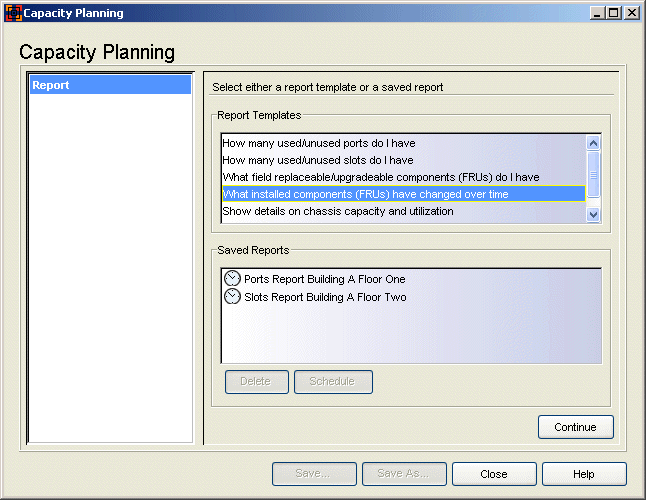
- Report Templates
- Lists the available report templates. Each report template is designed to answer a specific capacity planning question.
- Saved Reports
- Lists all your saved reports including reports saved by other Inventory Manager clients connected to the
server. After you have created a report using a template, you can save it as a
Saved Report, by clicking the Save button. This allows you to save
specific report attributes and parameters, so that you can regenerate the
same report at a later time. The schedule icon
 indicates that a saved report has
been scheduled. You can remove a schedule from a saved report by
right-clicking on the report and selecting Delete > Schedule.
indicates that a saved report has
been scheduled. You can remove a schedule from a saved report by
right-clicking on the report and selecting Delete > Schedule.
- Schedule Button
- When you have selected a saved report in the Saved Reports list, this button opens the Schedule Report window where you can configure scheduling information and notification settings for the report.
Select Targets Window
Use this window to select the target devices for your report and add filters to further refine the list of devices, if desired. For example, you could target the Chassis device group, but filter out a single chassis you don't want included in the report. Or, you could target the Chassis device group, and filter in just one specific chassis type. Once you have made your selections, you can view a list of the devices you have targeted for your report to verify that your targets are correct.
Click the graphic for more information.
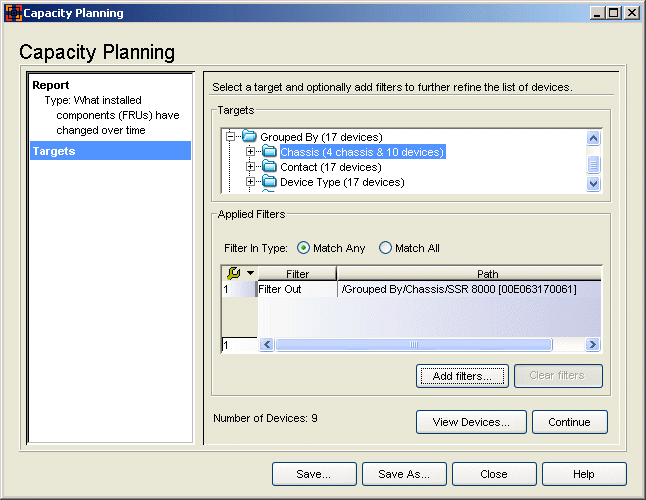
- Targets
- This panel displays your Network Elements tree. Expand the tree to select the target device group or individual device for your report.
- Applied Filters
- Lists any filters applied to your selected targets. Click the Add Filters button to open the Add Filters window and create your filters.
- Filter In Type
- If you have defined one or more "Filter In" filters, select how you want
the filters to work:
- Match Any - A device can match any of the filter-in filters to be included as a target. For example, if you have selected the Grouped By device group and you filter in the 6C105 device group and the 6C107 device group, any device that is in the 6C105 or 6C107 device group will be included as a target.
- Match All - A device must match all of the filter-in filters to be included as a target. For example, if you have targeted the Grouped By device group and you filter in the Floor One device group and the Chassis device group, any device that is on Floor One and in the Chassis device group will be included as a target.
- Number of Devices
- A running total of the number of target devices with filters applied. Click View Devices to view a list of the target devices.
- Add Filters Button
- Opens the Add Filters window, where you can create filters to further qualify the list of devices for your report.
- View Devices Button
- Opens the View Devices window where you can see a list of the selected devices that will be included in your report.
Select FRU Types Window
Use the checkboxes in this window to select the specific components (FRU types) for your report. Select the "Any" checkbox for a report on all the listed types, or select individual types to narrow down the focus of your report.
Click the graphic for more information.
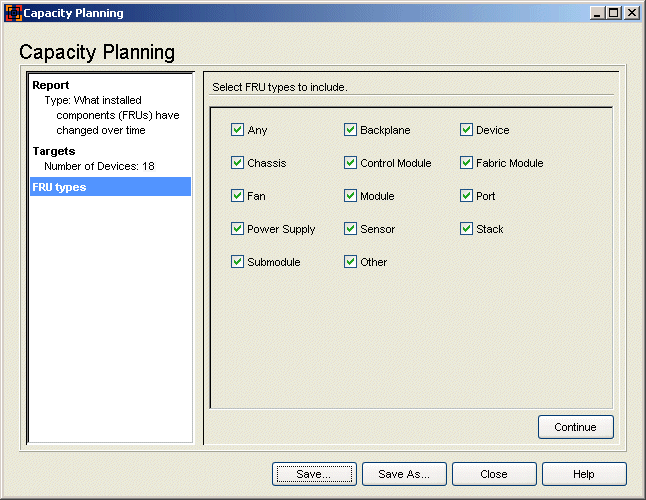
- FRU Types to Include
- Use the checkboxes in this window to select specific FRU types for your
report. Select the "Any" checkbox for a report on all listed FRU types,
or select individual FRU types of interest. Select the "Other" checkbox if
you wish to include data on FRU types other than the ones listed here. For
the purposes of this report, the FRU types are defined as follows:
- Backplane -- a device for aggregating and forwarding networking traffic, such as a shared backplane in a modular Ethernet switch. A backplane may be reported as a single physical entity, even if it is actually implemented as multiple discrete physical components within a chassis or stack.
- Device -- a manageable networking device.
- Chassis -- an overall container for networking equipment.
- Control Module -- the module in a chassis that is responsible for maintaining route table and bridge table information, as well SNMP management and system housekeeping functionality.
- Fabric Module -- a switching fabric module that provides direct communication between fabric-enabled line cards in a chassis.
- Fan -- a fan or other heat-reduction component.
- Module -- a self-contained subsystem, such as a plugin card, daughter-card, or DFE module.
- Port -- a media connector added to a module, submodule, or standalone device.
- Power Supply -- a power-supplying component.
- Sensor -- a sensor such as a temperature sensor within a router chassis.
- Stack -- a stack of multiple chassis.
- Submodule -- an expansion module installed on an existing chassis module or standalone device that adds ports to the existing device. This should not be confused with a Port Interface Module (PIM), which adds media connectors to a module, submodule, or standalone device. For example, the 6E129-26 has two PIM slots, which would not be included in the definition of a submodule. These PIMs would be reported as port FRUs.
Specify Time Window
Use this window to select a time period from which report data will be gathered. The report will be generated using device data saved in archive operations performed during the specified time period. Calculations are based on the first and last archives (data samples) in the time period selected, not on all archive information in the specified time frame. The archive operations must be configured to archive capacity planning data (see How to Archive for more information.) You can also select to use current data from devices as one of your data samples, in which case the report will use current data from the target devices, instead of the last archive in the time period.
Click the graphic for more information.
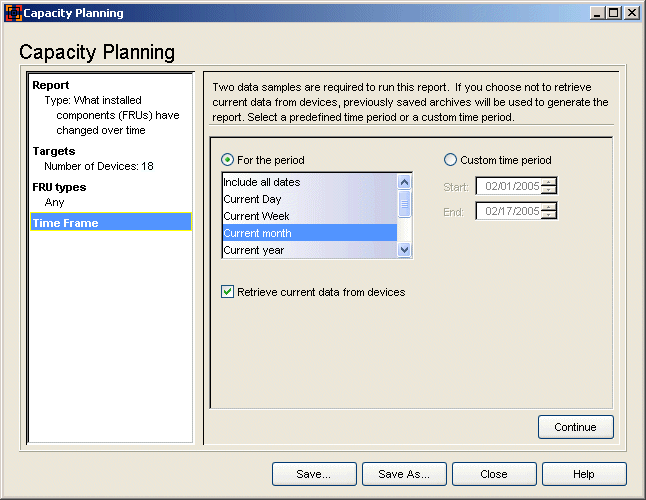
- For the Period
- Select a time period for your report. The report is generated using
device data saved in archive operations performed on the targeted devices
during the specified time period. Report
information is collected from the first and last archives
(data samples) in the
selected time period, not from every archive in the time period.
- Include all dates -- The report will use the first and last archives that exist for your target devices.
- Current Day -- The report will use the first and last archives from the current day.
- Current Week -- The report will use the first and last archives from the current week.
- Current month -- The report will use the first and last archives from the current month.
- Current year -- The report will use the first and last archives from the current year.
- Last month -- The report will use the first and last archives from the previous month.
- Last 3 months -- The report will use the first and last archives from the previous three months, not including the current month.
- Last 6 months -- The report will use the first and last archives from the previous six months, not including the current month.
- Last 12 months -- The report will use the first and last archives from the previous 12 months, not including the current month.
| TIP: | When you make a "For the Period" time selection, the "Custom time
period" Start and End dates are
automatically filled in with the selected dates. You can then switch to the Custom
time period option and refine your time period to the exact dates you would like.
For example, you could select the time period "Last 6 months", and then switch
to the Custom time period option and change the End date to the current date.
This would allow you to generate a report using data from the current month and
the last six months. |
|---|
- Retrieve current data from devices
- This checkbox is available when you select a time period where the End date is the current date. When the checkbox is selected, the report will use current data from the target devices, instead of the last archive in the time period. Because this requires the report to gather current data from the devices, extra time may be needed while report results are calculated.
- Custom Time Period
- Specify a custom time period for your report. Report information will be collected from the first and last archive (data samples) in the selected time period, not from every archive in the time period.
Results Window
Use this window to view the report data. The radio buttons at the top of the right panel let you select various ways to display the report results:
- Summary by FRU Type -- lists all the FRU components for your target devices, organized by FRU type.
- Added FRUs -- lists all the FRU components that have been added during the specified time frame.
- Removed FRUs -- lists all the FRU components that have been removed during the specified time frame.
- All FRU Details -- lists the details for each individual FRU component included in the report.
In addition, your selection in the tree determines the results displayed in the table. For example, you can select a device group and view report data for that group. Then, you can expand the group and view data for a specific device. As you change your selection in the tree, the table is updated with the results for your specific selection.
Results - Summary By FRU Type
The Summary by FRU Type view displays report data organized by FRU type, providing an easy way to view top-level information and quickly determine where to take a closer look. Your selections in the Select FRU Types window determine what FRU types are reported on.
| NOTES: |
|
|---|
Click the graphic for more information.
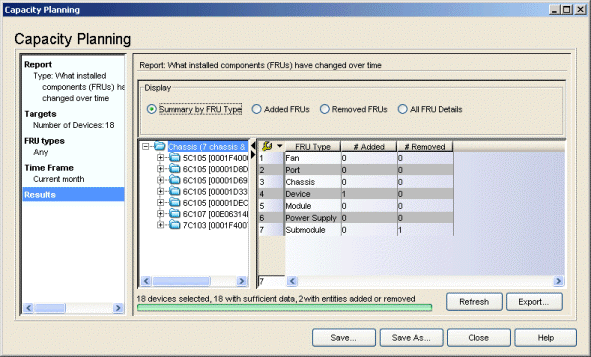
- Target Device Tree
- Displays your target groups and devices. Your selection in the tree determines what results data will be displayed in the table. For example, select a device group to see FRU type results summarized for that group, or select an individual device to see results for just that device. When you change your selection in the tree, the table is updated with the relevant information.
- Device Count, Sufficient Data
- The total number of target devices, followed by the number of devices with sufficient data to report results. A device is counted as having sufficient data if there were two data samples (either two archives, or one archive and current data) used to obtain report data. This area also reports the number of devices with FRU components that have been added or removed.
Table
The Summary by FRU Type table displays FRU data for the selected device group or for the individual devices contained in the group. The report is generated based on the first and last data samples in the time period selected. Devices with no data samples or only one data sample, will not be represented in the report results.
- FRU Type
- The type of FRU. Your selections in the Select FRU Types window determine the FRU types included in the report.
Results - Added FRUs
The Added FRUs view provides information on FRU components that have been added during the specified time frame. Your selections in the Select FRU Types window determine the components included in the report. Depending on your selection in the tree, you can see details for Added FRUs on all the devices in a group or just on an individual device.
Click the graphic for more information.
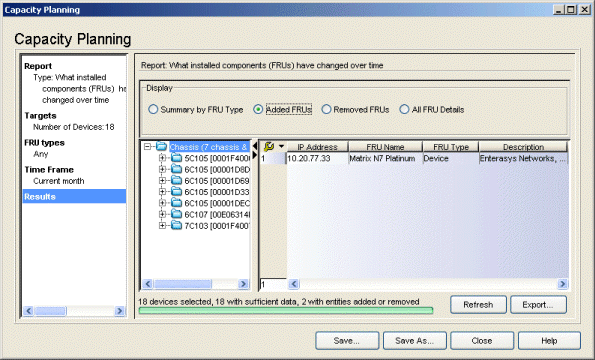
- Target Device Tree
- Displays your target groups and devices. Your selection in the tree determines what results data will be displayed in the table. For example, select a device group to see Added FRUs for that group, or select an individual device to see results for just that device. When you change your selection in the tree, the table is updated with the relevant information.
- Device Count, Sufficient Data
- The total number of target devices, followed by the number of devices with sufficient data to report results. A device is counted as having sufficient data if there were two data samples (either two archives, or one archive and current data) used to obtain report data. This area also reports the number of devices with FRU components that have been added or removed.
Table
The Added FRUs table displays FRU data for the selected device group or for the individual devices contained in the group. The report is generated based on the first and last data samples in the time period selected. Devices with no data samples or only one data sample, will not be represented in the report results.
Results - Removed FRUs
The Removed FRUs view provides information on FRU components that have been removed during the specified time frame. Your selections in the Select FRU Types window determine the components included in the report. Depending on your selection in the tree, you can see details for Removed FRUs on all the devices in a group or just on an individual device.
Click the graphic for more information.
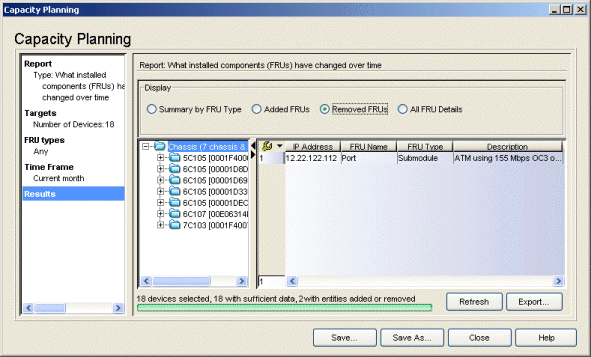
- Target Device Tree
- Displays your target groups and devices. Your selection in the tree determines what results data will be displayed in the table. For example, select a device group to see Removed FRUs for that group, or select an individual device to see results for just that device. When you change your selection in the tree, the table is updated with the relevant information.
- Device Count, Sufficient Data
- The total number of target devices, followed by the number of devices with sufficient data to report results. A device is counted as having sufficient data if there were two data samples (either two archives, or one archive and current data) used to obtain report data. This area also reports the number of devices with FRU components that have been added or removed.
Table
The Removed FRUs table displays FRU data for the selected device group or for the individual devices contained in the group. The report is generated based on the first and last data samples in the time period selected. Devices with no data samples or only one data sample, will not be represented in the report results.
FRU Results - All FRU Details
The FRU Details view provides information on the individual FRU components installed on your target devices. Your selections in the Select FRU Types window determine what components are included in the report. The report is generated based on the first and last data samples in the time period selected, resulting in two entries per FRU component (one for each data sample used.) Depending on your selection in the tree, you can see details for FRUs installed on all the devices in a group or just on an individual device.
| NOTES: |
|
|---|
Click the graphic for more information.
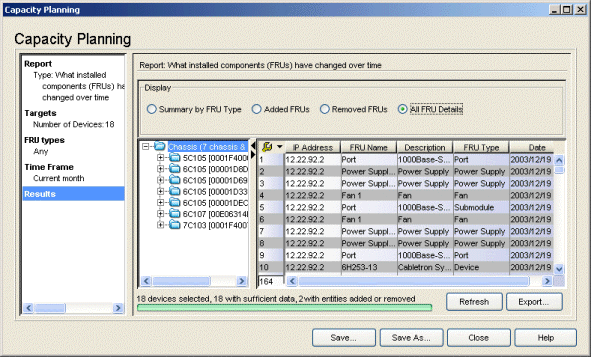
- Target Device Tree
- Displays your target groups and devices. Your selection in the tree determines what results data will be displayed in the table. For example, select a device group to see All FRU Details for that group, or select an individual device to see results for just that device. When you change your selection in the tree, the table is updated with the relevant information.
- Device Count, Sufficient Data
- The total number of target devices, followed by the number of devices with sufficient data to report results. A device is counted as having sufficient data if there were two data samples (either two archives, or one archive and current data) used to obtain report data. This area also reports the number of devices with FRU components that have been added or removed.
Table
The All FRU Details table displays information for each FRU component included in the report. The report is generated based on the first and last data samples in the time period selected which means that there will be two entries per FRU component, one for each data sample used. Devices with no data samples or only one data sample, will not be represented in the report results.
- Date
- The date and time the report data was generated using current data, or the date and time of the archive used to generate the report information. There will be two table entries per FRU component, one for each data sample used.
- Abort/Refresh Button
- This button toggles between Abort and Refresh. While a report is being generated, Abort stops the report and clears all data out of the table. Refresh restarts report generation and updates the table with new data. If you have selected the Retrieve current data from devices option in the Specify Time Frame window, clicking Refresh allows you to update your report results with the latest data from your devices. In addition, if you have selected a current time frame for your report, and a new archive is saved after your report results are generated, clicking Refresh will regenerate your results using the new archive data.
- Export Button
- Allows you to export your report results table as an HTML file or as a delimited text file. A Save window opens where you can name your exported file, select the file extension, and navigate to a folder/directory where you want save the file.
- Save/Save As Button
- Opens the Save Report window where you can name a report and then save it so that you can run the report again. You can also select a checkbox to schedule the report. This opens the Schedule Report window where you can configure scheduling information and notification settings for the report. Once you have saved a report, it appears in the Saved Reports list in the Select Report window, where you can select it.
For information on related windows: